Pipedreams Euro-Tour
April 28 - May 11, 2006
Saint Gallen (Cathedral)
St Gallen’s giant Baroque cathedral is unmissable. Designed by one Peter Thumb from Bregenz, it was completed in 1767 after just twelve years’construction work. From the enclosed Klosterhof, at the heart of the complex, you can see the full height of the extraordinary soaring east facade, dating from the 1760s. The convex facade of the apse rises above the formal lawns of the abbey, and is flanked by the two huge, concave towers rising in three sections. To the left is the palace wing, still the residence of the Bishop of St Gallen.
The interior of the cathedral is vast, a broad, brightly lit white basilica with three naves and a central cupola. Although not especially high, the interior has a sense of huge depth and breadth thanks to its accomplished architecture: from the sandstone of the floor and wood of the pews, fanciful light-green stuccowork - characteristic of churches in the Konstanz region - draws your
| |
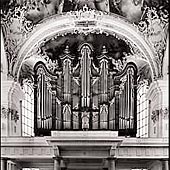 |
eye up the massive double-width pillars to the array of frescoes on the ceiling. The frescoes (1757-66) are almost entirely the work of one artist: Josef Wannenmacher, from Tomerdingen in southern Germany. Above the western end of the nave is a panel showing Mary sitting on a cloud surrounded by angels. The huge central cupola shows paradise, with the Holy Trinity in the centre surrounded by concentric rings of cloud on which are arrayed apostles and saints. Details throughout the rest of the cathedral are splendid: the lavish, mock-tasselled pulpit; the ornate choir screen; the richly carved walnut-wood confessionals; the intricate choir stalls; and, far away at the back of the choir, the high altar flanked by black marble columns with gold trim. The south altar features a bell brought by Gallus on his seventh-century journey from Ireland, one of the three oldest surviving bells in Europe. The set of nine bells, located in both towers and cast between 1616 and 1772, is the most complete historic set of swinging bells in Switzerland.
Within the same complex of buildings as the cathedral, and just adjacent to it, is the famous abbey library, or Stiftsbibliothek, one of the oldest libraries in Europe and classified by UNESCO as a World Heritage Site both for its stunning interior and for its
| |
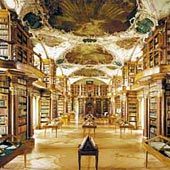 |
huge collection of rare and unique medieval books and manuscripts. You enter the library beneath a sign reading, in Greek, psyches iatreion, or “Pharmacy of the Soul”. The 28-by-10-metre room is acclaimed as Switzerland’s finest surviving example of a Baroque secular interior, and the first glimpse of it as you enter is dizzying. Designed by the same Peter Thumb who worked on the cathedral, the library dates from slightly later, so its orthodox Baroque architecture is overlaid with the opulent decoration of the Rococo period which then held sway. The four ceiling frescoes by Josef Wannenmacher depict with bold trompe l’oeil perspectives the early Christian theological councils of Nicaea, Constantinople, Ephesus and Chalcedon. Amongst the wealth of smaller frescoes set amongst the ceiling stucco, in the far southeast corner you’ll spot The Venerable Bede, a seventh-century English monk from Northumbria who wrote one of the first histories of England: he is shown as a scholar, with, beside him, a magic number square. This four-by-four sequence, where the numbers add up to 34 horizontally, vertically, diagonally and from the four corners, is thought to have been invented by Pythagoras in ancient Greece, but took on a new mystical power for early Christians who understood Christ to have died at 34 years of age.
The books are ranged on floor-to-ceiling shelves all around. You’re free to wander around and examine the spines - books were originally organized by subject, indicated by the cherubs at the head of capitals around the library, but are now arranged alphabetically. If you open the recessed panels between each bookcase, inside you’ll find registers of books in the nearby shelves with space to leave your name: the library still operates as an ordinary lending library and study centre, with some 140,000 volumes focused on the Middle Ages. Its list of cultural treasures is extraordinary - for a start, there are more Irish manuscripts in St Gallen than there are in Dublin, some fifteen handwritten examples from the seventh century and after, including a Latin manuscript of the Gospels dating from 750. Other works include an astronomical textbook written in 300 BC; copies made in the fifth century of works by Virgil, Horace and other classical authors; texts written by the Venerable Bede in his original Northumbrian language; the oldest book to have survived in German, dating from the eighth century; and a plan of Saint Gallen monastery drawn on parchment in the early ninth century to serve as a blueprint for construction of new buildings. Various of these and other treasures of the library’s upstairs manuscript room (no public access) are put on display in glass cases dotted around the main library area. An ancient Egyptian mummy in the library dates from 700 BC and was a gift to the mayor of St Gallen at the beginning of the nineteenth century; unsure of what to do with the thing, he plonked it in this corner, where it has sat incongruously ever since.)
Links and resources
Winterthur (Stadtkirche)
With its twin towers, the Stadtkirche (City Church) is Winterthur’s center and landmark. The first building on the site was a wooden chapel built in the 7th century, which was replaced by a massive stone building in the 9th century. The building of the present church started around the year 1000. A fire damaged the church and the north steeple in 1244 and the South steeple was added at the end of the 15th century. The three naves of the interior are dominated by wall paintings created by Paul Zehnder from Bern.
| |
 |
An organ was first mentioned in 1482. The small instrument was enlarged and transferred from the chancel to the nave in 1523. When, in 1524, organs and organ music in Switzerland were no longer allowed, the instrument (with Hauptwerk and Rückpositiv) was dismantled. It was not until 1808 that the parish of the Stadtkirche could buy an organ from the secularized abbey of Salem. This instrument with 42 stops on three manuals and pedal was built as a choir organ by Karl Joseph Riepp in 1768 for Salem Abbey. The organbuilder Gottfried Maucher re-erected the Salem organ in 1809 in Winterthur on a screen that separated the nave from the chancel. Later, the Rückpositiv division was transferred into the main case, and the number of original bellows was reduced. All of these changes caused considerable malfunctions.
In the 1970s, after numerous changes to the instrument, it was decided to reconstruct the organ’s original state of 1888 (Walcker). These works were executed by organ builder Kuhn from 1980 to 1984. Three stops from 1932 were also kept, and the specs were reduced to 56. Thanks to this restoration, one of the great German late Romantic organs was preserved.
Links and resources
Zurich (Grossmünster)
Grossmünster is the main church in Zurich and has been the starting point of the German-Swiss reformation under the reformator Huldrych Zwingli who served as a priest here from 1519 until his death. The three-nave basilica has been built over a period of more than 100 years. In 1100, chancel and crypt had been built adjacent to an older nave which was replaced by today’s nave in 1180. Finally the church was completed in 1260, followed by the completion of the towers in Late Gothic style, later in 1760 the spires were rebuilt in Baroque style. In the interior, there are remarkable Roman sculptures in Lombardic tradition. The wall frescoes are created in the 13th and 15th centuries, the baptism font from 1598, the pulpit from 1853, the stained glass windows in the chancel from 1932, the bronce portals from 1935-50, made bei Otto Muench.
The impressive west gallery houses a large organ with 67 speaking Stopps on four manuals and pedal, built in 1960 by the Swiss
| |
 |
company of Metzler & Söhne (Dietikon). Most of the highly decorated facade of the instrument is made of ornamented copper pipes and contrasts elegantly with the case and its dark green color. Names and symbols of the evangelists are engraved in the ornaments of the pedal facade pipes as well as the shields of the parish. All front pipes have their regular lengths and are sounding, there are no silent pipes in the front. The Hauptwerk is placed in the center, underneath the horizontal trumpets, above the enclosed Oberwerk, flanked with the two pedal towers, in front of the main case left and right the two Positivs, with their front pipes derived from the stops Prinzipal 4′ and Suavial 8′.
Links and resources
The day to day…

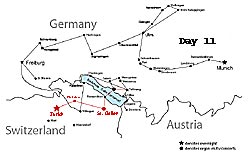
 Notes from the Road - travel log, day 11
Notes from the Road - travel log, day 11 Michael Barone’s pictures from the tour
Michael Barone’s pictures from the tour Images from Saint Gallen
Images from Saint Gallen Images from Winterthur
Images from Winterthur Images from Zurich Grossmünster
Images from Zurich Grossmünster Day 10 - Lindau & Dornbirn
Day 10 - Lindau & Dornbirn Day 12 - Männedorf & Zurich
Day 12 - Männedorf & Zurich Main Tour Page
Main Tour Page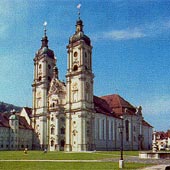


 Notes from the Road - travel log, day 11
Notes from the Road - travel log, day 11 Images from Saint Gallen
Images from Saint Gallen Description of the Cathedral - Switzerland is Yours
Description of the Cathedral - Switzerland is Yours Abbey of Saint Gall - Wikipedia
Abbey of Saint Gall - Wikipedia Description of the Cathedral - Magic Switzerland
Description of the Cathedral - Magic Switzerland Find detailed organ specifications in our Tour Book
Find detailed organ specifications in our Tour Book
 Notes from the Road - travel log, day 11
Notes from the Road - travel log, day 11 Images from Winterthur
Images from Winterthur Panoramic view of Winterthur
Panoramic view of Winterthur Find detailed organ specifications in our Tour Book
Find detailed organ specifications in our Tour Book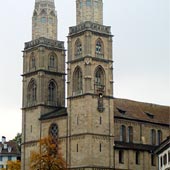

 Notes from the Road - travel log, day 11
Notes from the Road - travel log, day 11 Images from Zurich Grossmünster
Images from Zurich Grossmünster History of Grossmünster
History of Grossmünster Panoramic view of Grossmünster
Panoramic view of Grossmünster Find detailed organ specifications in our Tour Book
Find detailed organ specifications in our Tour Book

